
| Version | Summary | Created by | Modification | Content Size | Created at | Operation |
|---|---|---|---|---|---|---|
| 1 | Neelima Mahato | -- | 4115 | 2023-08-14 07:17:43 | | | |
| 2 | Jason Zhu | Meta information modification | 4115 | 2023-08-21 04:33:56 | | |
Video Upload Options
Cosmetics have always been in demand across the globe among people of all age groups. In the modern cosmetic world, nanostructured materials have proven hugely advantageous in producing cosmeceuticals or ‘nano-cosmeceuticals’ and various beauty products. The application of nanostructured materials in cosmetic products possesses some challenges in terms of short- and long-term safety and environmental issues, despite their growing popularity. The nanostructured particles in cosmeceuticals provide a targeted route of administration due to their high penetrability, site selectivity, high effectiveness, prolonged activity, and drug encapsulation potential. However, standard methods for toxicity evaluation may not be relevant for cosmeceuticals, leading to the need for an alternative methodology.
1. Introduction
1.1. Significance of Nanomaterials
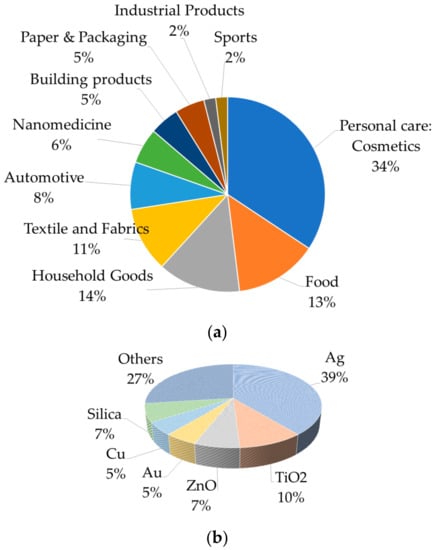
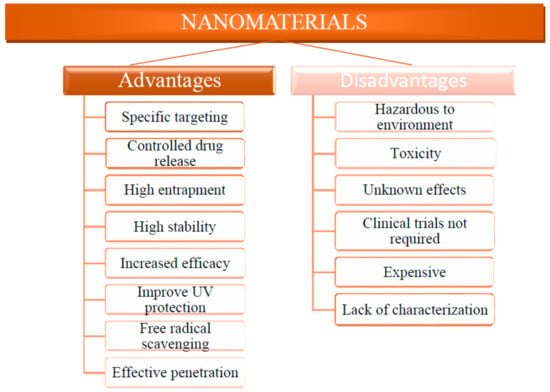
1.2. Worldwide Scenario of Cosmetics Production
1.3. Market Analysis of Nano-Cosmetic Pigments on the Basis of Type, Application, and Geography
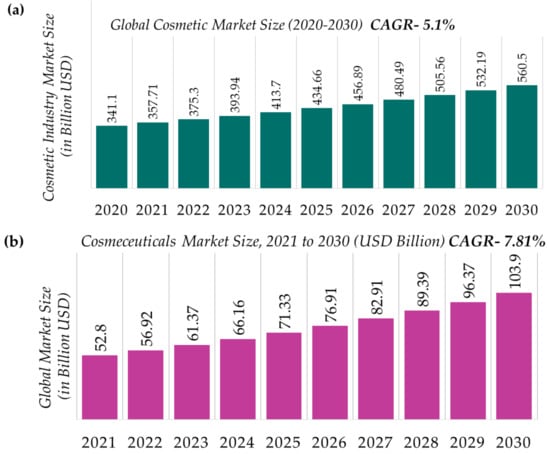

2. Synthesis of Nanostructured Materials
2.1. Phytogenic and Microbial Biosynthesis of Metallic Nanoparticles
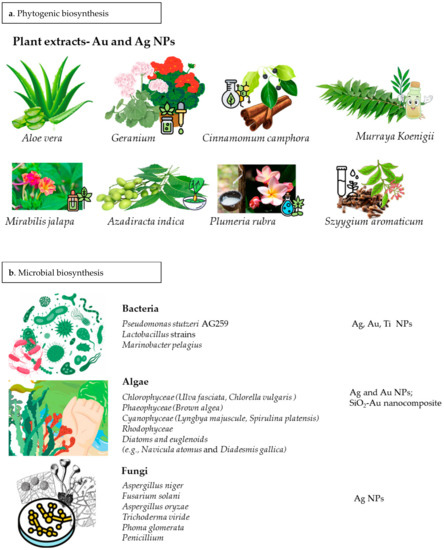

2.2. Chemical and Physical Methods of Synthesis
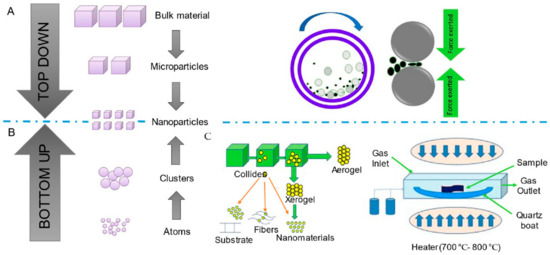
3. Organic Nanostructured Materials in Cosmetics Industry

3.1. Liposomes
3.2. Nano-Emulsions
3.3. Niosomes
3.4. Nanocapsules
3.5. Solid Lipid Nanostructured Particles (SLN)
3.6. Cubosomes
3.7. Dendrimers

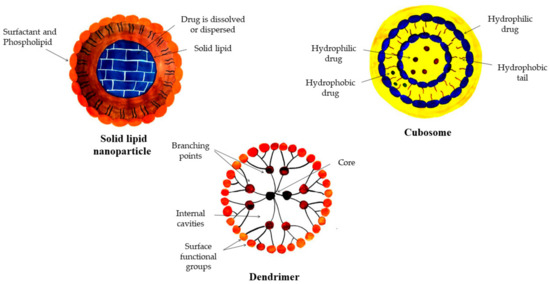
4. Inorganic Nanostructured Materials in Cosmetics Industries
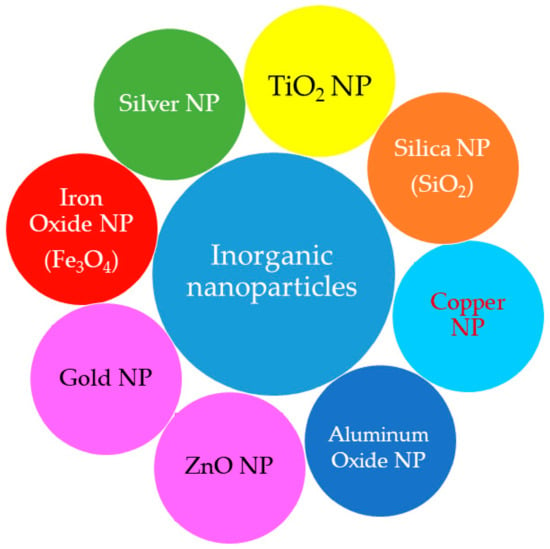
4.1. Nanostructured Particles of Silver and Gold
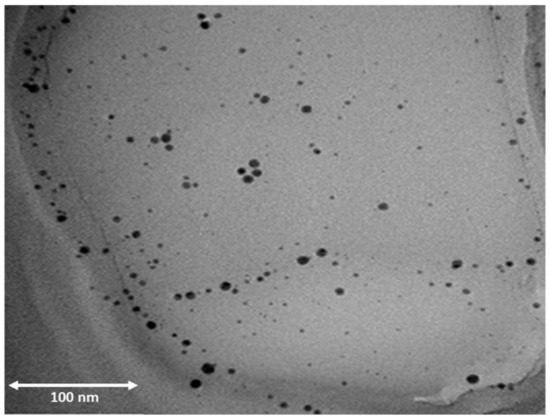
4.2. Silica Nanostructured Particles

4.3. Titanium Oxide and Zinc Oxide Nanostructured Particles
References
- Barik, T.K.; Maity, G.C.; Gupta, P.; Mohan, L.; Santra, T.S. Nanomaterials: An Introduction. Nanomater. Their Biomed. Appl. 2021, 16, 1–27.
- Chauhan, A.; Chauhan, C. Emerging trends of nanotechnology in beauty solutions: A review. Mater. Today Proc. 2021, 81, 1052–1059.
- Kaul, S.; Gulati, N.; Verma, D.; Mukherjee, S.; Nagaich, U. Role of Nanotechnology in Cosmeceuticals: A Review of Recent Advances. J. Pharm. 2018, 2018, 3420204.
- Dhapte-Pawar, V.; Kadam, S.; Saptarsi, S.; Kenjale, P.P. Nanocosmeceuticals: Facets and aspects. Futur. Sci. OA 2020, 6, FSO613.
- Manikanika; Kumar, J.; Jaswal, S. Role of nanotechnology in the world of cosmetology: A review. Mater. Today Proc. 2021, 45, 3302–3306.
- Fytianos, G.; Rahdar, A.; Kyzas, G.Z. Nanomaterials in Cosmetics: Recent Updates. Nanomaterials 2020, 10, 979.
- Nath, R.; Chakraborty, R.; Roy, R. Nanotechnology Based Cosmeceut icals. Int. J. Sci. Res. Sci. Technol. 2021, 8, 94–106.
- Shende, P.; Patel, D.; Takke, A. Nanomaterial-based cosmeceuticals. In Handbook of Functionalized Nanomaterials for Industrial Applications; Elsevier: Amsterdam, The Netherlands, 2020; pp. 775–791.
- Bilal, M.; Iqbal, H.M.N. New Insights on Unique Features and Role of Nanostructured Materials in Cosmetics. Cosmetics 2020, 7, 24.
- Santos, A.C.; Morais, F.; Simões, A.; Pereira, I.; Sequeira, J.A.D.; Pereira-Silva, M.; Veiga, F.; Ribeiro, A. Nanotechnology for the development of new cosmetic formulations. Expert Opin. Drug Deliv. 2019, 16, 313–330.
- Lohani, A.; Verma, A.; Joshi, H.; Yadav, N.; Karki, N. Nanotechnology-Based Cosmeceuticals. Int. Sch. Res. Not. 2014, 2014, 843687.
- Hameed, A.; Fatima, G.R.; Malik, K.; Muqadas, A. Scope of Nanotechnology in Cosmetics: Dermatology and Skin Care Products. J. Med. Chem. Sci. 2019, 2019, 9–16.
- Bayda, S.; Adeel, M.; Tuccinardi, T.; Cordani, M.; Rizzolio, F. The History of Nanoscience and Nanotechnology: From Chemical–Physical Applications to Nanomedicine. Molecules 2020, 25, 112.
- Ekpa Effiong, D.; Uwah, T.O.; Udofa Jumbo, E.; Akpabio, A.E. Nanotechnology in Cosmetics: Basics, Current Trends and Safety Concerns—A Review. Adv. Nanopart. 2020, 9, 1–22.
- Singh, T.G.; Sharma, N. Nanobiomaterials in cosmetics: Current status and future prospects. In Nanobiomaterials in Galenic Formulations and Cosmetics: Applications of Nanobiomaterials; Elsevier Inc.: Amsterdam, The Netherlands, 2016; pp. 149–174.
- Gupta, V.; Mohapatra, S.; Mishra, H.; Farooq, U.; Kumar, K.; Ansari, M.J.; Aldawsari, M.F.; Alalaiwe, A.S.; Mirza, M.A.; Iqbal, Z. Nanotechnology in Cosmetics and Cosmeceuticals—A Review of Latest Advancements. Gels 2022, 8, 173.
- Yadav, A.R.; Mohite, S.K. Applications of nanotechnology in cosmeceuticals. Res. J. Top. Cosmet. Sci. 2020, 11, 83–88.
- Aziz, Z.A.A.; Mohd-Nasir, H.; Ahmad, A.; Setapar, S.H.M.; Peng, W.L.; Chuo, S.C.; Khatoon, A.; Umar, K.; Yaqoob, A.A.; Ibrahim, M.N.M. Role of Nanotechnology for Design and Development of Cosmeceutical: Application in Makeup and Skin Care. Front. Chem. 2019, 7, 1–15.
- Zhang, L. Applications, challenges and development of nanomaterials and nanotechnology. J. Chem. Soc. Pak. 2020, 42, 658–666.
- Yadwade, R.; Gharpure, S.; Ankamwar, B. Nanotechnology in cosmetics pros and cons. Nano Express 2021, 2, 022003.
- Abu Hajleh, M.N.; Abu-Huwaij, R.; Al-Samydai, A.; Al-Halaseh, L.K.; Al-Dujaili, E.A. The revolution of cosmeceuticals delivery by using nanotechnology: A narrative review of advantages and side effects. J. Cosmet. Dermatol. 2021, 20, 3818–3828.
- Ferraris, C.; Rimicci, C.; Garelli, S.; Ugazio, E.; Battaglia, L. Nanosystems in Cosmetic Products: A Brief Overview of Functional, Market, Regulatory and Safety Concerns. Pharmaceutics 2021, 13, 1408.
- Beauty and Personal Care Products Market—Growth, Trends, and Forecasts (2023–2028). Available online: https://www.mordorintelligence.com/industry-reports/global-beauty-and-personal-care-products-market-industry (accessed on 8 March 2023).
- Global Beauty Products Market and Luxury Beauty Market 2022—Product Demand, Worldwide Consumption, Top Brands, Competition, Growth Rates, Investments, Production, Supply Chain and Future Stats Projection 2028. Available online: https://www.globenewswire.com/en/news-release/2022/02/21/2388521/0/en/Global-Beauty-Products-Market-and-Luxury-Beauty-Market-2022-Product-Demand-Worldwide-Consumption-Top-Brands-Competition-Growth-Rates-Investments-Production-Supply-Chain-and-Future-.html (accessed on 11 March 2023).
- Demir, N. Nanotechnology in cosmetics: Opportunities and challenges. NanoEra 2021, 1, 19–23.
- Cosmeceuticals Market (By Product: Skin Care, Hair Care, Injectable, Others; By Packaging Material: Glass, Plastic, Metal, Others; By Ingredient: Anti-Oxidants, Sunscreens, Botanicals, Peptides & Proteins, Exfoliants, Moisturizers, Retinoids; By Distribution Channel: Online Platforms, Supermarkets and Specialty Stores)—Global Industry Analysis, Size, Share, Growth, Trends, Regional Outlook, and Forecast 2022–2030. Available online: https://www.precedenceresearch.com/cosmeceuticals-market (accessed on 11 March 2023).
- Cosmetic Pigments Market (By Elemental Composition: Inorganic Pigments, Organic Pigments; By Application: Facial Makeup, Eye Makeup, Lip Products, Nail Products, Hair Color Products, Special effect & Special Purpose Products, Others; By Type: Special Effect Pigments, Surface Treated Pigments, Nano Pigments, Natural Colorants)—Global Industry Analysis, Size, Share, Growth, Trends, Regional Outlook, and Forecast 2022–2030. Available online: https://www.precedenceresearch.com/cosmetic-pigments-market (accessed on 11 March 2023).
- Nanomaterials Market (By Product: Carbon Nanotubes, Titanium Nanoparticles, Silver Nanoparticles, Aluminum Oxide Nanomaterials, Gold (Au), Iron (Fe), Copper (Cu), Platinum (Pt), Nickel (Ni), Antimony Tin Oxide, Bismuth Oxide, Others; By Application: Aeros. Available online: https://www.precedenceresearch.com/nanomaterials-market (accessed on 8 March 2023).
- Global Nano Cosmetic Pigments Market by Types (Titanium Dioxide, Zinc Oxide, Carbon Black, Iron Oxide, and Others), Applications (Facial Make-up, Lip Products, Eye Make-Up, Nail Products, Hair Color Products, Special Effect & Special Purpose Products, and Others), Distribution Channels (Online, Supermarkets/Hypermarkets, Specialty Stores, and Others), Age Groups (Teens, Adults, and Seniors), and Regions (Asia Pacific, Europe, North America, Middle East & Africa, and Latin America)—Global Industry Analysis, Growth, Share, Size, Trends, Opportunities, and Forecast From 2023 To 2031. Available online: https://dataintelo.com/report/nano-cosmetic-pigments-market/ (accessed on 11 March 2023).
- Inorganic Cosmetic Pigments Market: Information by Type, Application and Region-Forcast Till 2030. Available online: https://www.marketresearchfuture.com/reports/inorganic-cosmetics-pigments-market-10531 (accessed on 8 March 2023).
- Global Cosmetic Pigments Market Size By Elemental Composition (Organic , Inorganic , By Product , By Application Facial Make-Up , Eye Makeup, Lip care, Hair Care Products, Nail Care, Others Industry Analysis Report, Country Outlook Application Potential, Price Trends, Competitive Market Share & Forecast, 2020–2026. Available online: https://www.gminsights.com/industry-analysis/cosmetic-pigments-market (accessed on 11 March 2023).
- Cosmetics Market (By Category: Skin & sun care products, Hair care products, Deodorants & fragrances, Makeup & color cosmetics; By Gender: Men, Women, Unisex; By Distribution Channel: Hypermarkets/Supermarkets, Specialty Stores, Pharmacies, Online sales channels, Other)—Global Industry Analysis, Size, Share, Growth, Trends, Regional Outlook, and Forecast 2021–2030. Available online: https://www.precedenceresearch.com/cosmetics-market (accessed on 10 March 2023).
- Vaseghi, Z.; Nematollahzadeh, A.; Tavakoli, O. Green methods for the synthesis of metal nanoparticles using biogenic reducing agents: A review. Rev. Chem. Eng. 2018, 34, 529–559.
- Sidhu, A.K.; Verma, N.; Kaushal, P. Role of Biogenic Capping Agents in the Synthesis of Metallic Nanoparticles and Evaluation of Their Therapeutic Potential. Front. Nanotechnol. 2022, 3, 801620.
- Ghosh, S.; Ahmad, R.; Banerjee, K.; AlAjmi, M.F.; Rahman, S. Mechanistic Aspects of Microbe-Mediated Nanoparticle Synthesis. Front. Microbiol. 2021, 12, 638068.
- Ghosh, S.; Ahmad, R.; Zeyaullah; Khare, S.K. Microbial Nano-Factories: Synthesis and Biomedical Applications. Front. Chem. 2021, 9, 626834.
- Gahlawat, G.; Choudhury, A.R. A review on the biosynthesis of metal and metal salt nanoparticles by microbes. RSC Adv. 2019, 9, 12944–12967.
- Khandel, P.; Shahi, S.K. Mycogenic nanoparticles and their bio-prospective applications: Current status and future challenges. J. Nanostruct. Chem. 2018, 8, 369–391.
- Karthik, L.; Kumar, G.; Kirthi, A.V.; Rahuman, A.A.; Rao, K.V.B. Streptomyces sp. LK3 mediated synthesis of silver nanoparticles and its biomedical application. Bioprocess Biosyst. Eng. 2014, 37, 261–267.
- Eugenio, M.; Müller, N.; Frases, S.; Almeida-Paes, R.; Lima, L.M.T.; Lemgruber, L.; Farina, M.; de Souza, W.; Sant’Anna, C. Yeast-derived biosynthesis of silver/silver chloride nanoparticles and their antiproliferative activity against bacteria. Univ. Glas. 2016, 6, 13–52.
- Gade, A.; Ingle, A.; Whiteley, C.; Rai, M. Mycogenic metal nanoparticles: Progress and applications. Biotechnol. Lett. 2010, 32, 593–600.
- Owaid, M.N.; Ibraheem, I.J. Mycosynthesis of nanoparticles using edible and medicinal mushrooms. Eur. J. Nanomed. 2017, 9, 5–23.
- Shu, M.; He, F.; Li, Z.; Zhu, X.; Ma, Y.; Zhou, Z.; Yang, Z.; Gao, F.; Zeng, M. Biosynthesis and Antibacterial Activity of Silver Nanoparticles Using Yeast Extract as Reducing and Capping Agents. Nanoscale Res. Lett. 2020, 15, 1–9.
- Khanna, P.; Kaur, A.; Goyal, D. Algae-based metallic nanoparticles: Synthesis, characterization and applications. J. Microbiol. Methods 2019, 163, 105656.
- Kargozar, S.; Mozafari, M. Nanotechnology and Nanomedicine: Start small, think big. Mater. Today Proc. 2018, 5, 15492–15500.
- Ibrahim, N.A.; Zaini, M.A.A. Nanomaterials in detergents and cosmetics products: The mechanisms and implications. In Handbook of Nanomaterials for Manufacturing Applications; Elsevier Inc.: Amsterdam, The Netherlands, 2020; pp. 23–49.
- Naz, M.Y.; Shukrullah, S.; Ghaffar, A.; Ali, K.; Sharma, S.K. Synthesis and Processing of Nanomaterials. In Handbook of Materials Structures, Properties, Processing and Performance; Springer: Berlin/Heidelberg, Germany, 2014; pp. 1–17.
- Nagaich, U. Nanocosmeceuticals: A boon to personal care products. J. Adv. Pharm. Technol. Res. 2016, 7, 1.
- Tiwari, S.; Talreja, M.S. A concept of nanotechnology in cosmetics: A complete overview. Adalya J. 2020, 9, 14–23.
- Abbasi, B.H.; Fazal, H.; Ahmad, N.; Ali, M.; Giglioli-Guivarch, N.; Hano, C. Nanomaterials for cosmeceuticals: Nanomaterials-induced advancement in cosmetics, challenges, and opportunities. In Nanocosmetics; Elsevier Inc.: Amsterdam, The Netherlands, 2020; pp. 79–108.
- Souto, E.B.; Fernandes, A.R.; Martins-Gomes, C.; Coutinho, T.E.; Durazzo, A.; Lucarini, M.; Souto, S.B.; Silva, A.M.; Santini, A. Nanomaterials for Skin Delivery of Cosmeceuticals and Pharmaceuticals. Appl. Sci. 2020, 10, 1594.
- Milam, E.C.; A Rieder, E. An Approach to Cosmeceuticals. J. Drugs Dermatol. 2016, 15, 452–456.
- Milam, E.C.; Rieder, E.A. An approach to cosmeceuticals. In Essential Psychiatry for the Aesthetic Practitioner; Wiley Online Library: Hoboken, NJ, USA, 2021; pp. 42–48.
- Nakhaei, P.; Margiana, R.; Bokov, D.O.; Abdelbasset, W.K.; Kouhbanani, M.A.J.; Varma, R.S.; Marofi, F.; Jarahian, M.; Beheshtkhoo, N. Liposomes: Structure, Biomedical Applications, and Stability Parameters With Emphasis on Cholesterol. Front. Bioeng. Biotechnol. 2021, 9, 705886.
- Nikam, N.R.; Patil, P.R.; Vakhariya, R.R.; Magdum, C.S. Liposomes: A Novel Drug Delivery System: An Overview. Asian J. Pharm. Res. 2020, 10, 23–28.
- Faria-Silva, A.C.; Costa, A.M.; Ascenso, A.; Ribeiro, H.M.; Marto, J.; Gonçalves, L.M.; Carvalheiro, M.; Simões, S. Nanoemulsions for cosmetic products. Nanocosmetics 2020, 59–77.
- Sonneville-Aubrun, O.; Yukuyama, M.N.; Pizzino, A. Application of Nanoemulsions in Cosmetics. In Nanoemulsions: Formulation, Applications, and Characterization; Elsevier Inc.: Amsterdam, The Netherlands, 2018; pp. 435–475.
- Pandey, V.; Shukla, R.; Garg, A.; Kori, M.L.; Rai, G. Nanoemulsion in cosmetic: From laboratory to market. In Nanocosmetics; Elsevier Inc.: Amsterdam, The Netherlands, 2020; Volume 201, pp. 327–347.
- Marzuki, N.H.C.; Wahab, R.A.; Hamid, M.A. An overview of nanoemulsion: Concepts of development and cosmeceutical applications. Biotechnol. Biotechnol. Equip. 2019, 33, 779–797.
- Chevalier, Y.; Bolzinger, M.-A. Micelles and Nanoemulsions. In Nanocosmetics; Springer International Publishing: Berlin/Heidelberg, Germany, 2019; pp. 47–72.
- Khan, R.; Irchhaiya, R. Niosomes: A potential tool for novel drug delivery. J. Pharm. Investig. 2016, 46, 195–204.
- Mehrarya, M.; Gharehchelou, B.; Poodeh, S.H.; Jamshidifar, E.; Karimifard, S.; Far, B.F.; Akbarzadeh, I.; Seifalian, A. Niosomal formulation for antibacterial applications. J. Drug Target. 2022, 30, 476–493.
- Suttee, A.; Mishra, V.; Nayak, P.; Singh, M.; Sriram, P. Niosomes: Potential Nanocarriers for Drug Delivery. Int. J. Pharm. Qual. Assur. 2020, 11, 389–394.
- Kaur, D.; Kumar, S. Niosomes: Present Scenario and Future Aspects. J. Drug Deliv. Ther. 2018, 8, 35–43.
- Aparajay, P.; Dev, A. Functionalized niosomes as a smart delivery device in cancer and fungal infection. Eur. J. Pharm. Sci. 2022, 168, 106052.
- Pandey, P.; Purohit, D.; Jalwal, P.; Manchanda, D.; Saini, S.; Verma, R.; Kaushik, D.; Mittal, V.; Kumar, M.; Bhattacharya, T.; et al. Nanocapsules: An Emerging Drug Delivery System. Recent Patents Nanotechnol. 2022.
- Chawla, S.; Thakkar, D.; Rai, P. Utilization of Consumer Nanoproducts for Cosmetics and Their Impacts. In Handbook of Consumer Nanoproducts; Springer: Singapore, 2021; pp. 1–23.
- Hatahet, T.; Morille, M.; Hommoss, A.; Devoisselle, J.-M.; Müller, R.; Bégu, S. Liposomes, lipid nanocapsules and smartCrystals®: A comparative study for an effective quercetin delivery to the skin. Int. J. Pharm. 2018, 542, 176–185.
- An, Q.; Ni, X.; Liu, D.; Zhang, Y.; Cao, Y. Preparation and evaluation of polymer-encapsulated UV filter nanocapsules with miniemulsion polymerization. J. Dispers. Sci. Technol. 2021, 42, 1593–1600.
- Mohd-Setapar, S.H.; John, C.P.; Mohd-Nasir, H.; Azim, M.M.; Ahmad, A.; Alshammari, M.B. Application of Nanotechnology Incorporated with Natural Ingredients in Natural Cosmetics. Cosmetics 2022, 9, 110.
- Paliwal, R.; Paliwal, S.R.; Kenwat, R.; Das, K.B.; Sahu, M.K. Solid lipid nanoparticles: A review on recent perspectives and patents. Expert Opin. Ther. Pat. 2020, 30, 179–194.
- Ahmad, J. Lipid nanoparticles based cosmetics with potential application in alleviating skin disorders. Cosmetics 2021, 8, 84.
- Formulation, N.F. Sunscreen Boosting Effect by Solid Lipid Nanoparticles-Loaded Fucoxanthin Formulation. Cosmetics 2020, 7, 14.
- Jose, J.; Netto, G. Role of solid lipid nanoparticles as photoprotective agents in cosmetics. J. Cosmet. Dermatol. 2019, 18, 315–321.
- Sadhu, V.R.; Beram, N.S.; Kantamneni, P. A review on cubosome: The novel drug delivery system. GSC Biol. Pharm. Sci. 2018, 5, 076–081.
- Chaudhary, K.; Sharma, D. Cubosomes: A Potential Drug Delivery System. Asian J. Pharm. Res. Dev. 2021, 9, 93–101.
- Kaur, S.D.; Singh, G.; Singh, G.; Singhal, K.; Kant, S.; Bedi, N. Cubosomes as Potential Nanocarrier for Drug Delivery: A Comprehensive Review. J. Pharm. Res. Int. 2021, 33, 118–135.
- Gaballa, S.; El Garhy, O.; Abdelkader, H. Cubosomes: Composition, preparation, and drug delivery applications. J. Adv. Biomed. Pharm. Sci. 2020, 3, 1–9.
- Dhadwal, A.; Sharma, D.R.; Pandit, V.; Ashawat, M.S.; Kumar, P. Cubosomes: A Novel Carrier for Transdermal Drug Delivery. J. Drug Deliv. Ther. 2020, 10, 123–130.
- Sherje, A.P.; Jadhav, M.; Dravyakar, B.R.; Kadam, D. Dendrimers: A versatile nanocarrier for drug delivery and targeting. Int. J. Pharm. 2018, 548, 707–720.
- Kraeling, M.E.; Topping, V.D.; Belgrave, K.R.; Schlick, K.; Simanek, E.; Man, S.; Dadiboyena, S.; Patri, A.K.; Sprando, R.L.; Yourick, J.J. In Vitro Skin Penetration of Dendrimer Nanoparticles. Appl. Vitr. Toxicol. 2019, 5, 134–149.
- Ambre, P.K.; Gupta, C.R.; Martis, E.A.F.; Coutinho, E.C. Chapter 8—Self-assemblies, dendrimers, and nanoparticles. In Handbook on Nanobiomaterials for Therapeutics and Diagnostic Applications; Anand, K., Saravanan, M., Chandrasekaran, B., Kanchi, S., Jeeva Panchu, S., Chen, Q., Eds.; Elsevier: Amsterdam, The Netherlands, 2021; pp. 151–189.
- Simonescu, C.M. Introductory Chapter: Dendrimers as Nanoengineered Materials and Their Applications. Dendrimers-Fundam. Appl. 2018, 10–13.
- Rudolf, R.; Jelen, Z.; Zadravec, M.; Majeric, P.; Jovic, Z.; Vuksanovic, M.; Stankovic, I.; Matija, L.; Dragicevic, A.; Thompson, N.M.; et al. A gold nanoparticles and hydroxylated fullerene water complex as a new product for cosmetics. Adv. Prod. Eng. Manag. 2022, 17, 89–107.
- Kantorová, V.; Loula, M.; Kaňa, A.; Mestek, O. Determination of silver nanoparticles in cosmetics using single particle ICP-MS. Chem. Pap. 2021, 75, 5895–5905.
- Kim, S.-H.; Lee, D.H.; Choi, S.; Yang, J.-Y.; Jung, K.; Jeong, J.; Oh, J.H.; Lee, J.H. Skin Sensitization Potential and Cellular ROS-Induced Cytotoxicity of Silica Nanoparticles. Nanomaterials 2021, 11, 2140.
- Wu, F.; Deng, J.; Hu, L.; Zhang, Z.; Jiang, H.; Li, Y.; Yi, Z.; Ngai, T. Investigation of the stability in Pickering emulsions preparation with commercial cosmetic ingredients. Colloids Surf. A Physicochem. Eng. Asp. 2020, 602, 125082.
- Åhlén, M.; Cheung, O.; Strømme, M. Amorphous Mesoporous Magnesium Carbonate as a Functional Support for UV-Blocking Semiconductor Nanoparticles for Cosmetic Applications. ACS Omega 2019, 4, 4429–4436.
- Kose, O.; Tomatis, M.; Leclerc, L.; Belblidia, N.-B.; Hochepied, J.-F.; Turci, F.; Pourchez, J.; Forest, V. Impact of the Physicochemical Features of TiO2 Nanoparticles on Their In Vitro Toxicity. Chem. Res. Toxicol. 2020, 33, 2324–2337.
- Lu, P.-J.; Huang, S.-C.; Chen, Y.-P.; Chiueh, L.-C.; Shih, D.Y.-C. Analysis of titanium dioxide and zinc oxide nanoparticles in cosmetics. J. Food Drug Anal. 2015, 23, 587–594.
- Vinod, T.P.; Jelinek, R. Inorganic Nanoparticles in Cosmetics. In Nanocosmetics: From Ideas to Products; Cornier, J., Keck, C.M., de Voorde, M., Eds.; Springer International Publishing: Cham, Switzerland, 2019; pp. 29–46.




